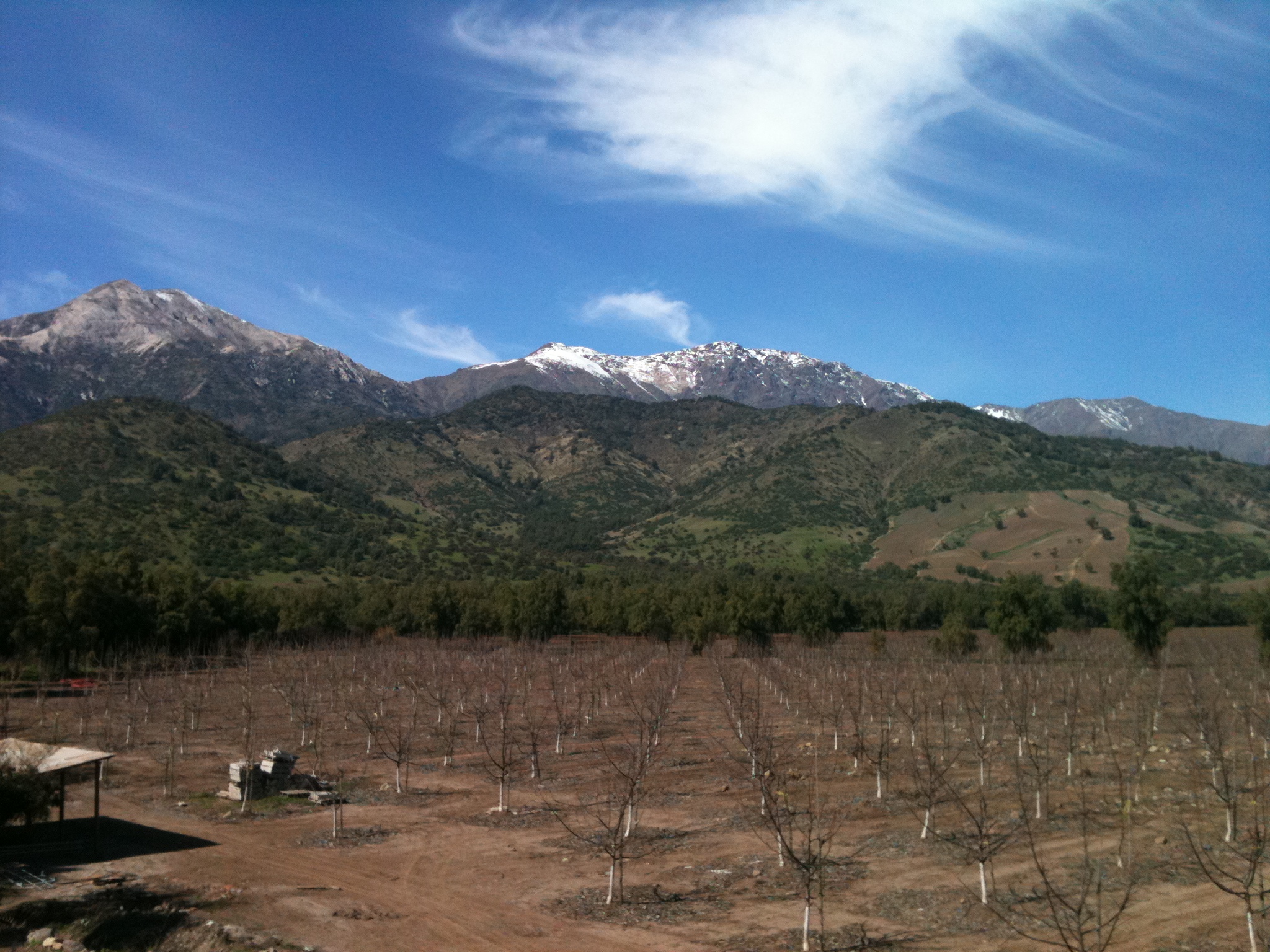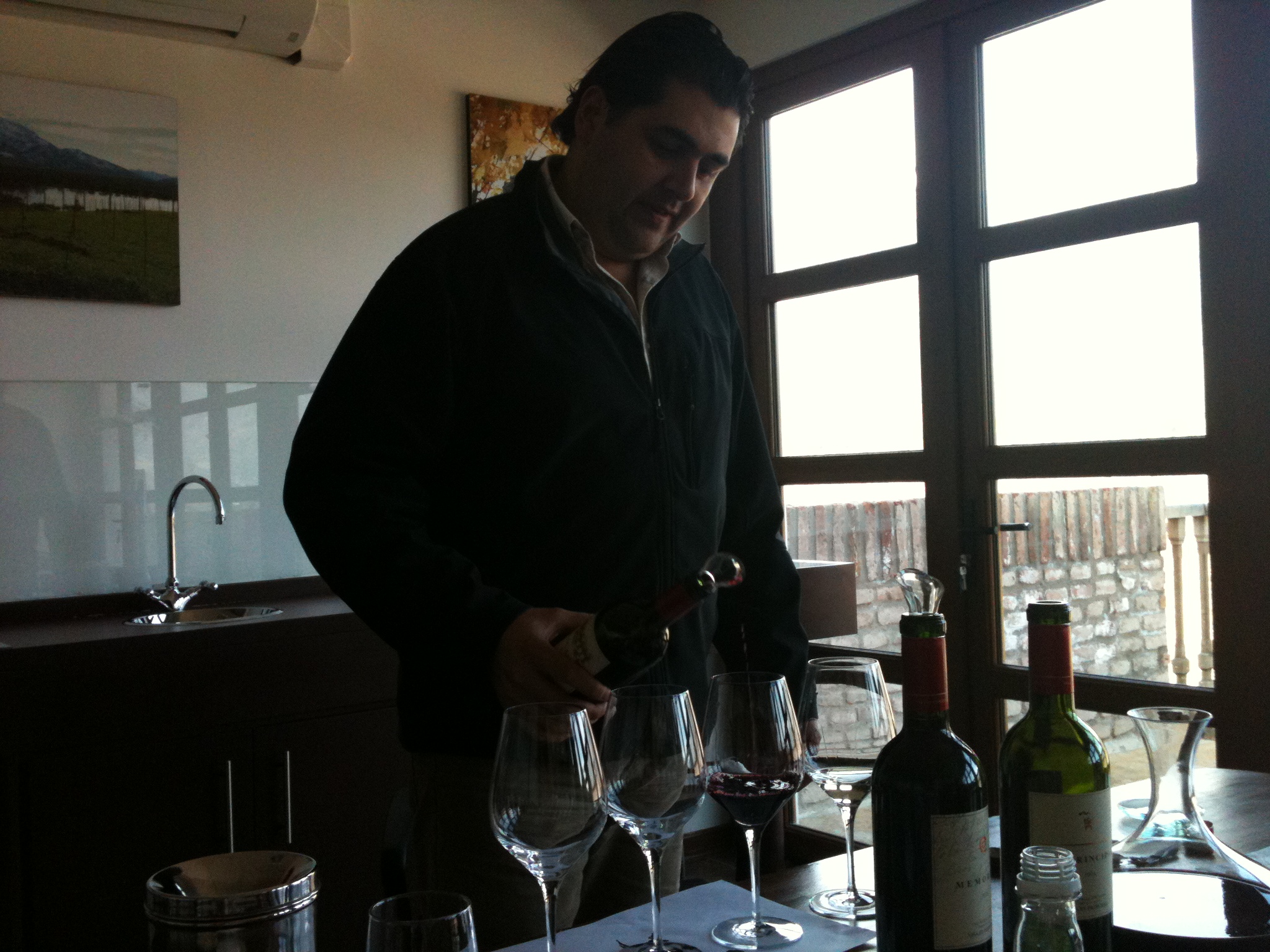When we talk about terroir-driven wines, one of the first wineries that Springs to mind, for my palate, is El Principal. Never heard of it? You’re probably not alone. It’s one of those (purposefully) under-the-radar wineries that pursues excellence in small quantities with a select, loyal audience that gets its mission and appreciates its wines. If you want to truly know the potential of the Alto Maipo terroir in the Andean foothills east of Pirque, these wines will open that door to you. If you try them blind, I am most certain you would never, ever suspect they are Chilean.
Last week we caught up with the winemaker Gonzalo Guzmán on site to see how the project has evolved over the past four years since the project changed owners. We walked the property, tasted the new wines and vintages, and talked about life, a shared love of wine, what terroir really is, our wine “babies” (err, collections), and more.
History
Originally founded in 1998, El Principal winery was originally a partnership between Jorge Fontaine, owner of the Hacienda El Principal, and Jean-Paul Valette, former owner of Chateau Pavie in Saint Émilion, France (father of well known Chilean-French winemaker consultant Patrick Valette’s father). The objective? To produce top-quality red wines in this tiny, rugged corner of the Maipo in the French tradition. Fifty-four hectares of the property were selected and planted with high-density plots of Cabernet Sauvignon, Merlot, Carmenere and Cabernet Franc.
The story turned sad when Jean-Paul died right before the 1999 harvest. His son, Patrick, stepped forward to oversee the project and processed the 1999 (first) harvest, and El Principal was born. Fast forward several years later. Jochen Doehle, the German owner of Doehle Latinamerica (logistics), bought the vineyard from the Valette family under the careful advisory of Geo Wines. Thus, a new team headed by winemaker Gonzalo Guzmán took over the project with the vision to further transform this astounding piece of Maipo terroir into something with even more potential and the long-term mission to produce some of the finest, Bordeaux-style wines from the “New World”.
The Terroir
El Principal is located the furthest east into the Andes of any other winery in Chile. Truly, as you approach the winery, you are surrounded by the chiseled granite peaks of the Andes cutting into the sky, sprinkled with white snow and year-round glaciers. Fifteen minutes east of Pirque, you feel like you are deep in the heart of the campo, countryside. Here, chickens run loose along the road, small farms are still tended by families, and the tiny kinship surrounding the winery, El Principal, feels like a far flung village. The only sounds are birds chirping and the wind rustling. Bucolic, in a word.
The vineyards are located along the hillsides on the piedmont with alluvial (poor) soil facing north. The ranges in soil in these vineyards are staggering given its relatively small surface area. The hills have light-colored clay, marbled with lime sediments, stone, and gravel, making for good drainage. One thing I felt very important in understanding was that the river water is chock full of trace minerals like iron which lend a subtle complexity to the wines. And obviously, given the vineyard is located in the foothills, the Andes play a huge influence on the viticulture here with temperatures fluctuating over 20°C between day and night. This allows for a slower ripening process and yields grapes that are super intense in flavor with high concentrations of polyphenols (what makes red wine so “good” for you), and serious tannins.
The Winemaker’s Mission
I’ll be honest. From my first encounter with El Principal 1999 and 2001 vintage, I was smitten. Then the wines sort of disappeared even in Chile. What had happened to the other vintages? Changes, changes, changes.
Meet El Principal’s talented winemaker, Gonzalo Guzman, who has worked in winemaking in Chile (Viña Errazuriz-Ovalle), New Zealand (Villa María), and Spain. He explained that the change in ownership meant a lot of new direction for the wines. Only up until 2001, the wines, at that time El Principal and Memorias, were bottled. The rest of the vintages were sold in bulk. Eek!
Guzman first aimed to transform the wines being sold in bulk into the top-notch quality to be bottled under the label El Principal. Certainly, the north on El Principal’s compass is quality and to continue making terroir wines. Dohle has a non-interventionist policy and basically given Guzman Carte Blanche when it comes to making the best decisions for the wine.
So after the changeover, the new owner invested heavily in making better, “cleaner” winemaking then ever before. They put over US$2 million in refitting the winery with new tanks, climatized cellar and bottle areas, construction of deep wells to procure purer water, drip irrigation, new vertical presses (for smoother results), and a battery of new French oak barrels. Gonzalo’s also mapped out the vineyard by micro-zones by soil and climate to control the quality, and harvest, to a T. He even vinifies in the tanks by micro-lots. Obsessive? Maybe, a little. Definitely passionate for truly showing what this corner of the Maipo terroir be. He’s also staging out planting new varieties like Petit Verdot, Syrah, and a couple hectares of the Spanish white grapes, Verdejo and Albariño (to go with their amazing, uncommercialized Sauvignon Blanc named Alqui).
In talking to Gonzalo though, his real objective is to reveal the potential of the wines from 2006 onward where his mano, hand, comes into play. He truly understands the notion of terroir and how to coax it out in wines, using them as literally an artistic medium for expression. He’s looking for distinctive, FRESH fruit. Complex yet approachable wines that are what they are. He strives to show the true identity of these wines. He’s even doing something completely counter-tendency in slowly transforming the label El Principal from being a Carmenere-Cabernet blend to a pure Cabernet Sauvignon over the next three years. Why? Because this is one of the best areas in the world for Cabernet. Period. How else can you typify and exude the true nature of Maipo Cabernet by diluting it in a blend? It’s a different approach. Actually, it’s pretty old school. He readily recognizes that they have been making wines like this in Europe for centuries, always seeking to express the most typical and best characteristics of the wines born in a certain place. Why shouldn’t this be the case in Chile? That’s his mission.
The Wines
I love our job. This tasting and visit gave me such juice to continue doing what we do! Tasting the wines onsite with the winemaker, then at lunch, and then over the next 2 days. These wines need time to open so if you have patience, you will be rewarded. By our Sunday lunch, 48 hours after being unbottled, these were manjares, nectars. Every single wine is a unique gem.
Calicanto 2008
Named after the imposing bridge over the Mapocho River in Santiago built between 1767 and 1779 with lime and egg whites as “mortar”, this is a blend of 60% Cabernet Sauvignon and 40%W Carmenere, aged for 13 months in French oak barrels. The wine is fresh with spicy notes (like cloves) from the Carmenere and a deep cassis taste. In the mouth, it is balanced and mouthwatering. A bottle of this could disappear with little effort, especially at the retail price of 9.900 pesos (about US$20).
Memorias 2006
Memorias is made from Cabernet Sauvignon and Carmenere and aged for 14 months in French oak barrels. The increase in concentration here is obvious from first whiff, and then sip. Once again, freshness is immediately perceived in the aromas. This is an explosive, concentrated wine. I noticed a tension between this balance (elegance) of the fresh fruit and power of the tannins. It tugged and pulled. For being a 15% alcohol wine, while it is big, you would never know it. Nothing is out of balance: acidity, tannins, concentration all dance together in perfect harmony. (Retail 20.000, US$40)
El Principal 2006
The crown jewel of El Principal, this is a glimpse of where this is headed over the next few years to reach Gonzalo’s mission of one 100% estate Cabernet. In the mean time, this still has 17% Carmenere along with 83% Cabernet Sauvignon. The grapes hail from one particular area of the vineyard that is designated for this wine, of course, assuming the quality is there. It is handled delicately and aged in French oak barrels for 18 months.
This wine produced total umami for me, which does not happen frequently.It was ripe, FRESH, flavorful. It was deep and complex yet completely approachable with bright acidity. It oozed tons of juicy black plums, cherries, cassis, and a subtle minerality. It lingered for well over a few minutes. Perfect acidity and drink. One of the most mind-blowing wines I have tried in Chile this year. I cannot wait to see the evolution of this wines and future vintages. (Retail 43.000, US$85).
Procuring the Goods
El Principal is currently exporting to Brasil, Europe, and in the process of finding an importer for the US market. So if you’d like to get these, email me for more info on direct shipping. Or if you’re in Chile, score them at La Cav’s store in Alto Las Condes mall or in great restaurants like Baco Wine Bar (one of my favorite spots for wines in the capital). It’s worth the search. These are true Chilean wine terroir treasures. And thank you Gonzalo Guzman for your passion, diligence, and commitment to revealing these wines to the world!















